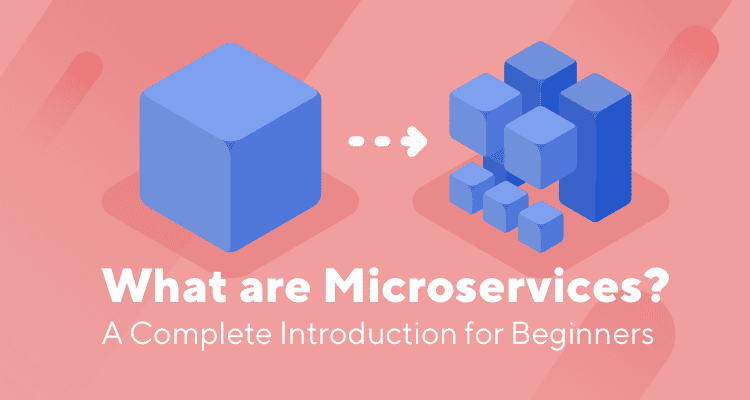
What are Microservices? A Complete Introduction for Beginners

Microservices are a type of architectural style for building software that has been gaining popularity. The concept was first introduced at a tech conference in 2011 and has been adopted by many Agile enterprises such as Netflix, Amazon, Uber, SoundCloud, Groupon, eBay, to name a few.
So, what are microservices? What are the benefits of microservices? And why are so many large enterprises have been implementing this method into their DevOps and continuous testing strategies?
We’re going to break down these concepts and give you a better understanding of how they work. Read on to find out!
What are Microservices?
Before jumping into the definition, let’s start with the early edition of microservices: monoliths.
Microservices evolves from the traditional monoliths or monolithic architecture. Legendary monolithic systems can be a burden to maintain and update. What worked well with the Waterfall method of software development is now obsolete in today’s Agile, Kanban, or Scrum teams. Monolithic applications are now too clunky to move fast, and those who don’t transition to microservices may soon be left in the dust.
Microservices, or microservices architecture, are the modern methods of designing software applications that compartmentalize the software into chunks of small and independent services.
The primary function of microservices architecture is quite simple: focusing on building. Instead of one code repository in a traditional monolithic style, microservices break up that repository into several smaller repositories.
How about the main benefits? Working with microservices enables rapid and frequent delivery for large and often complex applications while also increasing quality reliability.
Purpose of Microservices
Microservices matter to those who value the time spent going through massive codebases, which is often like finding a needle in a haystack.
When beginning to code a new product, working with a monolithic style is often a more natural approach to building up the codebase. The product is smaller and not as complex as more established products.
However, once the product becomes denser and more complicated, working with a microservices style is a great way to make the code easier to maintain. After all, adding new features or fixing a bug in the main codebase in a monolithic application can often trigger new bugs in another part of the code.
Transitioning from the larger monolithic codebase and establishing microservices makes it easier to pinpoint errors that may arise when adding new features or bug fixes. Knowing it can only be in a small section of code saves time for both the testers locating the bugs and developers for fixing the error.
Benefits of Microservices

Organized around business capabilities
Business capabilities are actions that businesses take to bring value. These actions are often structured around business objects, such as order and customer management, product and service development, demand generation, amongst others.
Independently deployable
Each service can be deployed at one time, which means less time is needed to test the entire application for any changes made to that specific service.
Highly maintainable and testable
As each service is independent of the other, making changes to that service would not affect the rest of the product’s codebase, resulting in easier maintenance and faster testing.
Loosely coupled
Microservices structures an application as a set of loosely coupled services, minimizing the dependencies of one service to another.
Small teams
The engineering division is organized into small, autonomous teams of 6 –10 members, on average, of which each team is responsible for one (or more) services.
How Do Microservices Work?
Microservices break each part of the codebase into multiple modular and loosely coupled components, through which each service performs one or more functions.
Each service should be aligned with business capabilities to ensure you are meeting each function’s requirements. These individual functions should be distributed across clouds and data centers and treated as an independent service, therefore allowing each to be changed, updated, or deleted without putting the rest of the application at risk.
Communication between each service is important to ensure seamless interaction. Microservices use APIs and communication protocols to work with each other. Building the service behind an API gateway allows for easier interaction. However, it also facilitates product efficiency, reduced coding efforts, and decreased risk of creating errors.
Whether starting from scratch and building a product using microservices right away or transitioning from a monolithic legacy application, microservices are a great way to have an easily maintainable and scalable product. With greater agility to create new features and fix bugs quickly, your product can get to market faster than the competition and also please your customers with quick updates.
Types of Microservices
In general, there are two types of microservices:
Stateless
Stateless services act as the foundation for a distributed application. This type of microservices does not maintain the session state between requests. If any service within the application is removed, it would not affect the processing logic for that service, and it would become a part of the overall application. Stateless microservices is recommended If using a distributed system.
Stateful
As microservices are independent of one another, whenever two or more microservices communicate, stateful microservices maintain a service request state by storing session information in the code. Stateful services is a good type of microservices to use if there are cases where session information needs to be stored.
Microservices Implementation Approach

Beginning a new product has many challenges, one of which is how to organize your application’s codebase. Will you start with a monolithic architecture because you anticipate the product to be simple? Or do you think it will quickly transform into complex features that could benefit from a microservices architecture from the start?
Consider these two approaches to microservices as a part of your strategy.
Greenfield
The greenfield approach is when you begin microservices architecture from scratch. This is the best approach when developing a system in a new environment as there is no legacy system to integrate.
This approach is a higher risk, as is building any new infrastructure, and its best to use Agile software development to accommodate that risk. Using an Agile technique allows you to handle any risks by fully developing one service of the product at a time so that immediate feedback may be obtained (either internally or externally).
Brownfield
The brownfield approach is used when transitioning an existing monolithic legacy application to microservices architecture.
This approach tackles microservices in stages (otherwise, it would be considered greenfield if beginning all at once) – so make sure you have a strategy in place before beginning. Decide which part of the application should be started first, and then work incrementally until each service has been created.
Microservices and Containers
Microservices are most easily created and maintained if each service is placed in an isolated container. By utilizing cloud capabilities, you can run the service from anywhere and create a predictable environment. Each container is then a self-contained package that uses the smallest libraries and executables that are needed by that specific service.
Working with many containers requires an orchestration tool to help manage the application as a whole. Docker or Kubernates are great resources to use to help with your containerization efforts.
Containerization is a great way to independently test each service without running tests on the entire application. This significantly decreases the amount of time required to run tests, thereby allowing you to get the product or new feature into the hands of end users much faster. Also, if anything were to happen with that service, it alone could be shut down to be repaired; or, if a severe issue occurs, that container could be deleted to begin again.
Conclusion
There are many benefits of microservices as it is a powerful and trendy software development method that has been favored by large Agile enterprises. However, it is not a one-size-fits-all solution for every software development problem.
So keep this in mind: Before beginning a transition to microservices, make sure to fully evaluate if it is the right choice for your company. The transition process is time-consuming and expensive.
If the product generates revenue with a steady stream of users, then you should consider microservices. When the product inevitably expands to accommodate more users and features, the codebase will expand and make the monolithic architecture even more tedious to maintain. Therefore, microservices can be a great investment for your company if it has the revenue to justify the expense and assure stakeholders of beneficial returns.





